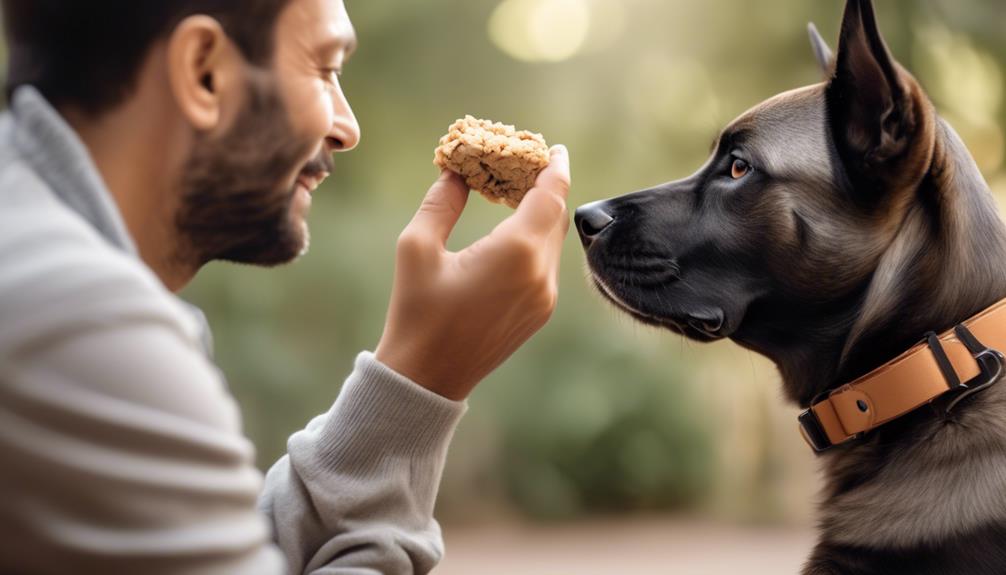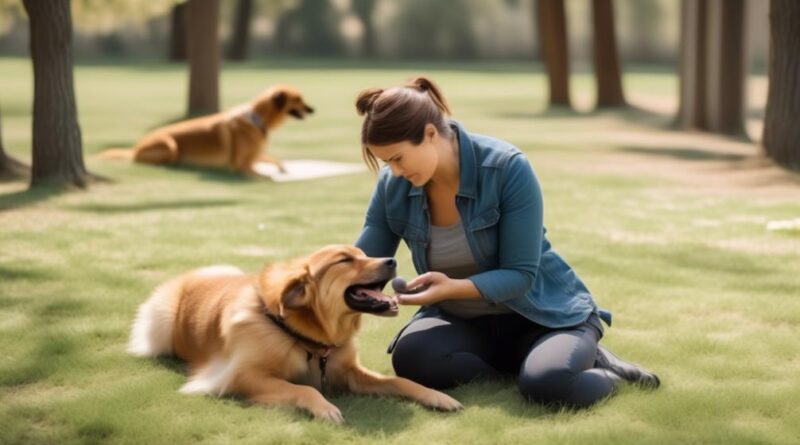Overcoming Fear and Phobias in Dogs: Expert Tips
Have you ever wondered if it's possible to help your fearful or phobic dog overcome their anxiety and fear? It can be a challenging journey, but with the right guidance and techniques, it is entirely achievable.
Many dog owners struggle with understanding and addressing their pet's fears, and the key to success often lies in patience, consistency, and expert advice.
As you navigate the complex world of canine fears and phobias, you'll discover actionable tips and insights that can make a significant difference in your dog's well-being.
Understanding Fear and Phobias in Dogs
Understanding fear and phobias in dogs can be crucial for pet owners in providing the necessary support and care for their furry companions. Behavioral modification plays a significant role in addressing these issues. It involves identifying triggers and gradually exposing the dog to them in a controlled manner to help reduce the fear response. This can be achieved through desensitization and counterconditioning, where the dog learns to associate the trigger with something positive, thereby changing its emotional response.
For instance, if a dog is fearful of loud noises, such as thunderstorms, gradually exposing the dog to the sound at a low volume while providing treats or engaging in a fun activity can help the dog form a positive association with the previously feared stimulus.
Anxiety management is another key aspect of addressing fear and phobias in dogs. This can involve creating a safe and secure environment for the dog, providing them with a comfortable space where they can retreat when feeling anxious. It's important to avoid reinforcing anxious behaviors and instead focus on rewarding calm and relaxed behaviors. Additionally, regular exercise and mental stimulation can help reduce anxiety in dogs. Engaging in activities such as interactive play, obedience training, and puzzle toys can provide an outlet for their energy and help alleviate anxiety.
Identifying Triggers and Signs
To effectively address fear and phobias in your dog, start by closely observing their behavior and reactions to different stimuli. This will help you identify specific triggers and signs of distress. Recognizing symptoms of fear and phobias in dogs is crucial for effective management.
Fearful dogs may exhibit trembling, panting, drooling, and attempts to escape or hide. They may also display signs of aggression, such as growling or barking. Additionally, watch for dilated pupils, ears pinned back, and a tucked tail, as these are common indicators of fear and anxiety in dogs.
Managing triggers involves identifying the specific stimuli that cause fear or phobias in your dog. Common triggers include loud noises, such as thunderstorms or fireworks, unfamiliar people or animals, certain objects, or specific environments. Pay close attention to your dog's body language and behavior when exposed to these triggers.
Understanding what sets off your dog's fear response will allow you to take proactive measures to minimize exposure to these triggers and implement positive reinforcement training to desensitize them over time.
Building Trust and Confidence
Building trust and confidence in your dog is essential for helping them overcome fear and phobias. Developing rapport with your dog is the foundation for building trust. Spend quality time with your dog, engaging in activities that they enjoy. This could be playing with their favorite toy, going for walks, or simply relaxing together. By showing them affection, patience, and consistency, you can strengthen your bond and establish a sense of security for your dog.
Boosting self-esteem in your dog is another crucial aspect of building trust and confidence. Positive reinforcement through rewards, such as treats or verbal praise, can help build their confidence. When your dog exhibits brave behavior or shows signs of overcoming a fear, acknowledge and reward their progress. This positive feedback will encourage them to continue their courageous behavior.
Additionally, creating a safe and predictable environment for your dog can significantly contribute to building trust and confidence. Establishing routines and providing a secure space where your dog feels comfortable can help alleviate their anxieties. By being attuned to your dog's body language and emotional cues, you can better understand their needs and create an environment that fosters confidence.
Desensitization and Counter-Conditioning
As you work on building trust and confidence with your dog, you can begin to address their fears through desensitization and counter-conditioning techniques.
Desensitization involves gradually exposing your dog to the source of their fear in a controlled and safe manner. For example, if your dog is afraid of strangers, you can start by having them at a distance where they feel comfortable and then slowly decrease the distance as they become more at ease. This gradual exposure allows your dog to adjust to the fear-inducing stimulus at their own pace, helping to reduce their fear response over time.
Counter-conditioning, on the other hand, focuses on creating a positive association with the fear-inducing stimulus. This involves pairing the presence of the feared object or situation with something enjoyable for your dog, such as treats, toys, or a favorite activity. For instance, if your dog is afraid of thunderstorms, you can offer them treats or engage them in play whenever there's a storm, helping them to associate the storm with something positive rather than fear.
Creating a Safe and Supportive Environment
When creating a safe and supportive environment for your dog, it's important to consider their individual needs and preferences. Dogs, like humans, thrive in environments that make them feel secure and at ease. To achieve this, it's crucial to exhibit comforting body language and provide a calm, soothing environment.
Your dog looks to you for reassurance and guidance, so your body language plays a significant role in creating a safe space. Use gentle, relaxed movements and a soft tone of voice to convey a sense of calm and security. Avoid making sudden or erratic movements, as this can trigger anxiety in a fearful dog. By maintaining a composed and comforting demeanor, you can help your dog feel more at ease in their surroundings.
In addition to your own behavior, the physical environment also plays a crucial role in your dog's sense of safety. Create a designated area in your home that's peaceful and free from loud noises or sudden movements. This can be a cozy corner with your dog's bed and favorite toys, providing them with a retreat where they feel secure. Consider using calming aids such as pheromone diffusers or soothing music to create a serene atmosphere.
Seeking Professional Help and Support
If your dog's fear or phobia is significantly impacting their well-being and quality of life, seeking professional help and support can be crucial in addressing and managing their condition.
Professional guidance is essential in dealing with severe fear or phobias in dogs. A certified dog behaviorist or a veterinarian with expertise in behavior can provide tailored strategies to help your dog overcome their fears. These professionals can conduct a thorough assessment of your dog's behavior, identify the triggers causing fear or anxiety, and develop a customized treatment plan. They may utilize desensitization and counterconditioning techniques to help your dog gradually become more comfortable and confident in fearful situations.
In addition to professional guidance, emotional support for both you and your dog is vital during this process. Dealing with a fearful or phobic dog can be emotionally challenging, and seeking support from a qualified professional can help you navigate this journey with greater ease. They can offer you advice, reassurance, and practical tools to support your dog effectively. Furthermore, they can help you understand the underlying causes of your dog's fears and provide you with the necessary skills to help your dog feel more secure and less anxious.
Implementing Positive Reinforcement Techniques

To effectively address your dog's fear or phobia, implementing positive reinforcement techniques can play a crucial role in helping them build confidence and overcome their anxieties. Behavior modification through reward-based training is a powerful tool for encouraging positive changes in your dog's behavior.
When your dog exhibits brave or relaxed behavior in situations that typically trigger fear, rewarding them with treats, praise, or play can reinforce these positive responses. This helps your dog understand that their calm behavior is desirable and leads to positive outcomes.
When implementing positive reinforcement techniques, consistency is key. Make sure that everyone interacting with your dog, including family members and visitors, follows the same reward-based training methods. This will help your dog understand what's expected of them and what behavior is being reinforced. Additionally, be patient and understanding as behavior modification takes time.
Avoid punishment-based training methods, as these can exacerbate fear and anxiety in your dog. Incorporating positive reinforcement techniques into your dog's daily routine can help them feel more secure and confident in various situations.
Patience and Consistency in Training
Implementing positive reinforcement techniques requires patience and consistency in your approach to training your dog. Training techniques and behavioral modification are most effective when approached with a calm and consistent demeanor. Here's how you can achieve this:
- Set Clear Expectations: Clearly communicate what behaviors you expect from your dog. Consistency in your expectations will help your dog understand what's required of them.
- Regular Training Sessions: Schedule regular training sessions to work on specific behaviors. Short, frequent sessions are more effective than sporadic, lengthy ones.
- Positive Reinforcement: Use treats, toys, or verbal praise to reward your dog for displaying the desired behavior. Consistently rewarding good behavior will reinforce it.
- Remain Patient: It's essential to remain patient throughout the training process. Dogs, like humans, need time to learn and adjust their behavior. Rushing or becoming frustrated can hinder progress.
Consistency and patience are key to successful training and behavioral modification. By maintaining a steady and patient approach, you can effectively communicate your expectations to your dog and reinforce positive behaviors. Remember that every dog is unique, and progress may take time. Stay consistent, be patient, and celebrate the small victories along the way.
Frequently Asked Questions
Are There Any Specific Breeds of Dogs That Are More Prone to Developing Fear and Phobias?
Certain breeds may have hereditary tendencies for fear development. Some specific breeds, like German Shepherds and Border Collies, are more prone to developing fear and phobias. However, individual experiences and upbringing also play a significant role.
Can Fear and Phobias in Dogs Be Hereditary?
Yes, fear and phobias in dogs can be hereditary. Genetic predisposition plays a role in the development of these traits. Some breeds are more prone, so it's important to consider a dog's lineage when addressing these issues.
How Can I Help My Dog Overcome Fear of Specific Sounds, Such as Thunderstorms or Fireworks?
You can help your dog overcome fear of specific sounds, like thunderstorms or fireworks, through desensitization training. Use sound therapy and calming supplements to aid in behavioral modification, gradually exposing your dog to the sounds.
Is There a Link Between Fear and Phobias in Dogs and Their Early Socialization Experiences?
Did your dog's early socialization experiences affect their fear and phobias? Yes, early socialization plays a crucial role. Behavior modification techniques, such as desensitization and counterconditioning, can help address these issues and improve your dog's well-being.
Are There Any Alternative Therapies or Treatments That Can Help Alleviate Fear and Phobias in Dogs?
You can explore alternative therapies for your dog's fear and phobias. A holistic approach, natural remedies, and behavioral modification techniques can all play a role in alleviating your dog's anxieties and fears.
Conclusion
You can help your dog overcome fear and phobias by understanding their triggers, building trust, and creating a supportive environment.
It takes patience and consistency, but with the right techniques and professional support, you can help your furry friend feel more confident and secure.
Remember to use positive reinforcement and take things at your dog's pace.
With time and effort, you can make a positive difference in your dog's life.
